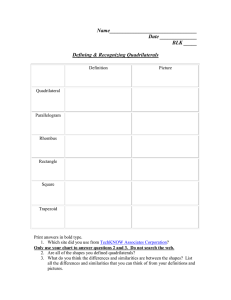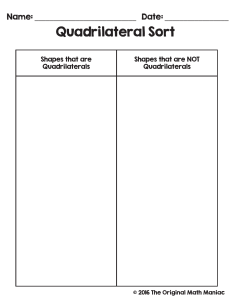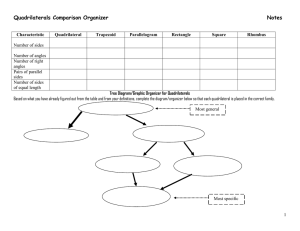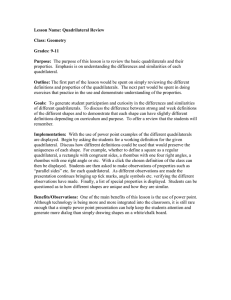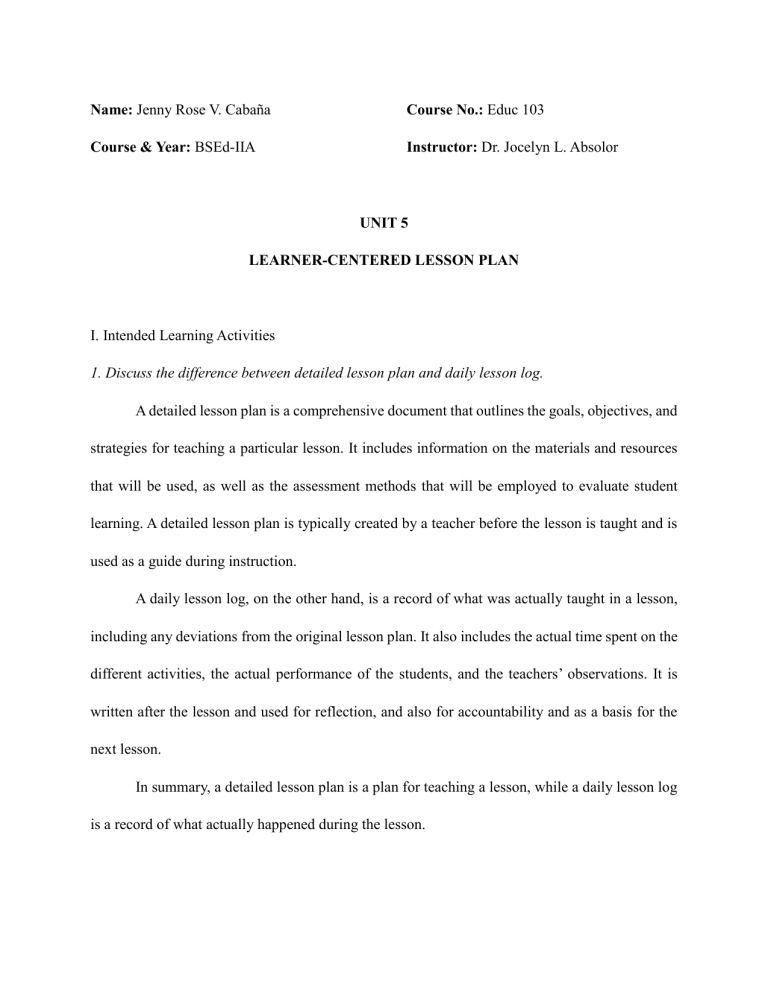
Name: Jenny Rose V. Cabaña Course No.: Educ 103 Course & Year: BSEd-IIA Instructor: Dr. Jocelyn L. Absolor UNIT 5 LEARNER-CENTERED LESSON PLAN I. Intended Learning Activities 1. Discuss the difference between detailed lesson plan and daily lesson log. A detailed lesson plan is a comprehensive document that outlines the goals, objectives, and strategies for teaching a particular lesson. It includes information on the materials and resources that will be used, as well as the assessment methods that will be employed to evaluate student learning. A detailed lesson plan is typically created by a teacher before the lesson is taught and is used as a guide during instruction. A daily lesson log, on the other hand, is a record of what was actually taught in a lesson, including any deviations from the original lesson plan. It also includes the actual time spent on the different activities, the actual performance of the students, and the teachers’ observations. It is written after the lesson and used for reflection, and also for accountability and as a basis for the next lesson. In summary, a detailed lesson plan is a plan for teaching a lesson, while a daily lesson log is a record of what actually happened during the lesson. 2. Why is lesson plan important? Lesson plans are important for a number of reasons: They provide a clear structure and direction for the lesson, ensuring that all necessary information and materials are covered and that instructional time is used efficiently. They help teachers to stay organized and focused during the lesson, reducing the likelihood of confusion or deviation from the intended learning objectives. They allow teachers to anticipate and plan for potential challenges or disruptions, and to have strategies in place to address them. They serve as a guide for evaluation and assessment, helping teachers to measure student learning and progress. They help to ensure that the curriculum is being implemented in a consistent and effective manner, and that students are receiving a well-rounded education. They are also important for accountability, as lesson plans can be used to demonstrate to school administrators, parents, or other stakeholders that instruction is aligned with standards and objectives. They also help the teacher to reflect on the teaching and learning process, to improve the subsequent lesson and instruction. Name: Jenny Rose V. Cabaña Course & Year: BSEd-IIA Course No.: Educ 103 Instructor: Dr. Jocelyn L. Absolor UNIT 5 LEARNER-CENTERED LESSON PLAN II. Assessment Construct a detailed lesson plan. DETAILED LESSON PLAN IN MATH 7 Length: 1 hour Prepared by: Jenny Rose V. Cabaña I. OBJECTIVES Students will able determine the similarities and differences between quadrilaterals by looking at their side, angle, and diagonal measures. Students will able discover the properties of the special quadrilaterals. Students will able look for and make use of structure II. SUBJECT MATTER Topic: Quadrilateral Properties and Relationships Reference: http://www.edu.com/quadrilaterals\ Davision, et. Al, Pre- Algebra Course 3, pp. 245-345 Materials: Laptop, Projector (for presenting the main visual aspect of the lesson)bond paper, flashcard. III. PROCEDURE Teacher’s Activity Students’ Activity Introduction: A. Greetings and prayer (2 minutes) Good Morning, Class! (Students will greet back.) (Class president) please lead the prayer. (Class president will lead the prayer) Yes, Ma’am. B. Checking of Attendance Before we start, may I ask the secretary of the (Reports the population of the class) class to report who is absent today? C. Conditioning Students’ Attention (2 minutes) How are you feeling today? (Students will answer.) That’s nice! So let’s sing the “ I LOVE MATH” (student will sing) “ M-A-T-H” “M-A-T-H” “I love MATH 2x” “M-A-T-H” “M-A-T-H” “I love MATH 2x” “It is so exciting 2x” “Very interesting” “M-A-T-H” “M-A-T-H” “I love MATH 2x” “It is so exciting 2x” “Very interesting” “I love MATH 2x” “Very good class! I think you are already energize and ready to participate to our discussions and activities. As I always say you can only talk if I ask.” (Student will answer “Yes ma’am”) Review: (5 minutes) “Do you still remember our last lesson about parallel and perpendicular line?” (Student will answer “Yes ma’am”) “Well, let me see if you really remember. We will have a game. Do you know 4 pics, 1 word?” (Student will answer “Yes ma’am”) “Good! I have 4 pictures, and you are going to identify what word is being represented by the pictures. Whoever gets the answer will receive a prize. Just raise your arm and don’t talk, understood? (Student will answer “Yes ma’am”) . First picture What is this? “Yes (name of student)?” “Very good (name of student)” (Student raise their arms) (student will answer “Right”) Second Picture What is this? “Yes (name of student)?” “Very good (name of student)” (Student raise their arms) (student will answer “Parallel”) “Who can give me a simple definition of (Student raise their arms) parallel?” “Yes (name of student)?” (Student will give me a simple definition of parallel) “Very good (name of student)” Third Picture What is this? “Yes (name of student)?” “Very good (name of student)” (Student raise their arms) (student will answer “Angle”) Last Picture What is this? “Yes (name of student)?” “Very good (name of student)” (Student raise their arms) (student will answer “Perpendicular”) “Who can give me a simple definition of perpendicular?” (Student raise their arms) “Yes (name of student)?” (Student will give me a simple definition of “Very good (name of student)” perpendicular) “Very good class, to those who answer come in front and get you prizes here and to those who didn’t answer better luck next time” (Student will get their prizes) Motivation: (10-minutes): “Now let’s moved on, I will divide you into 7 groups. This will be Group 1… Group 7. Form a circle now. We will have an activity entitled, "Look at me". I will give each group a shape, and what you are going to do is to describe the shape, for example, how many comers does a has, how many sides, what kind of lines is it made of and you will report it to the class. I will give you a bond paper and you are going to write here your descriptions and paste it on the board. I will give you 3 minutes to do the activity. Understood? (Students will answer) (The teacher distribute the shapes to the (Students already paste their answers on the students) board) After 3 minutes. Okay, we will start with group 1. (The leader will report their answer in front of the class) “Very Good Group 1.” “Next we have group 2” “Very Good Group 2.” (The leader will report their answer in front of the class) (Up to Group 7) Discussion: “Before our recently finished activity, (the student who describe the shapes) describe the shapes that I gave to you. Now, you are going to elaborate on these shapes. Pay attention, I will be giving you a random definition of those shapes that I gave to you then you will choose among this words or definitions that match to your shapes. Understand?” (Student will answer) (The teacher will give the flash cards and the student will match the given shapes to the given flash cards with definitions.) (Student will answer the given activity) (One representative in the group will present their activity) “In the shapes you describe, are they part of quadrilaterals?” (Student will answer Yes/No) Application: (15 minutes) “Do you understand the given activity class?” (Student will answer) “Now if you really understand the topic, we are going to have another activity. I will going to test your ability to identify what are the properties of the quadrilaterals. The name of our activity is “Who am I?!” I will give you a mixed up quadrilaterals properties and a blank chart. You will fill in the chart with the quadrilateral properties that belong to each specific quadrilateral. You will be able to work with your group mates, but each you will be responsible to turn in your own work at the end of the activity. I give you 15 minutes to do the activity, class keep quiet while answering, understood? ” (Student will answer) (While students are working, the teacher will circulate around the room to observe students’ work and provide help to students that need it.) After 15 minutes “Pass your papers” (Student will pass their papers) “Did you enjoy the activity?” (Student will answer) Generalization: “So, what are the types of quadrilaterals?” (Student will answer the six quadrilaterals) “How many sides are there in a kite” (Student will answer 4) “What did you observe about the types of quadrilaterals?” (Student will answer) “Very good! You really know now the properties of quadrilaterals.” types of IV. EVALUATION Teacher’s Activity Students’ Activity “Class, bring out ¼ sheet of paper and answer the following. I will give you 10 minutes to answer” Identify if the statement is true or false. Write "T" is the statement is true and “F” if the statement is false. 1. A rectangle is a parallelogram. 2. A square is a rhombus. 3. A square is a parallelogram. 4. A square is a quadrilateral 5. A rhombus is a square. 6. A square is a rectangle. 7. A rectangle is a square. 8. A trapezoid is a quadrilateral. 9. A kite is a trapezoid. 10. A trapezoid is an isosceles trapezoid. 1.T 2.T 3.T 4.T 5.F 6.T 7.F 8.T 9.F 10F After 10 minutes: “Stop writing and pass your papers to me.” (Students will pass their papers.) “Very good class now, let us do the I LOVE MATH clap.” The teacher will briefly demonstrate the I LOVE MATH clap which is composed of 3 claps, 3 stamps, and a shout of ‘I LOVE MATH.’ (Students will do the I LOVE MATH clap.) V. ASSIGNMENT Instruction: Create any creative artwork that represent any of the six quadrilaterals. For example a piece of wood that forms kite. (This will be pass on our next meeting.) Criteria: Creativity-40% Originality-40% Neatness-20% Total of 100%
